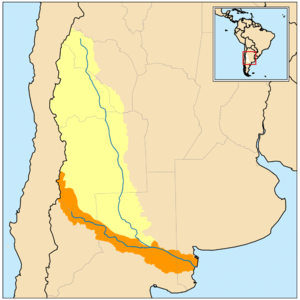Desaguadero River

The Desaguadero River (Spanish: Río Desaguadero, Spanish pronunciation: [ˈri.o ðesaɣwaˈðeɾo]) is the general name of a river in western Argentina that receives a number of different names on its path of 1,515 kilometres.
It is one of the major rivers that supplies the irrigated areas of Cuyo, and it flows in the eastern border of that region.[1]
History
The river marked the traditional boundary between the Vice-Royalties of Buenos Aires and Peru.[2]
Spring

Its source, a spring, is located in the Andes around coordinates 27°47′18″S 68°36′17″W / 27.78833°S 68.60472°W, at 5,500 metres of height, on the southern slope of the Cerro Bonete mountain, in the north of La Rioja Province, near the limit with Catamarca Province.
In La Rioja the river is named, in order, of Río de Oro, Río Bonete and Jagüé, though its mainly known as either Vinchina or Bermejo, creating sometimes confusion with the Bermejo River located further north.
Cuyo
The river continues south-southeast to cross the east of San Juan Province, were it receives the waters of tributaries Jáchal River and San Juan River (the latter itself fed by the Mendoza River). As it gets closer to the provinces of Mendoza and San Luis, it reaches a deeper area where it created the Lagunas de Guanacache lagoons, currently almost dried out.
Leaving the lagoon areas the river is called Desaguadero ("outlet") and becomes the natural boundary between Mendoza and San Luis provinces. From Mendoza it receives the tributaries Tunuyán, Diamante and Guandacol before reaching the parallel 36°S to then enter La Pampa Province. Shortly after it receives from the west the tributary Atuel River; the overflows of both rivers in that area form the Bañados del Atuel.
La Pampa
From these wetlands and down to the Urre Lauquén and La Salada lagoons, it receives the name of Chadileuvú or Chadileo, words in Mapuche that mean "Salty River" (Río Salado), another of the names it receives.
After Urre Lauquén it acquires yet another name - Curacó ("Stone Water"), finishing at the Colorado River near coordinates 38°50′07″S 64°58′47″W / 38.83528°S 64.97972°W.
References
- ↑ Kenneth D. Frederick (1975). "Historical Growth". Water Management and Agricultural Development: A Case Study of the Cuyo region of Argentina (2011 ed.). Johns Hopkins University Press. p. 23.
- ↑ David Marley. Wars of the Americas: A Chronology of Armed Conflict in the Western Hemisphere, 1492 to the Present. ABC Clio. p. 588.